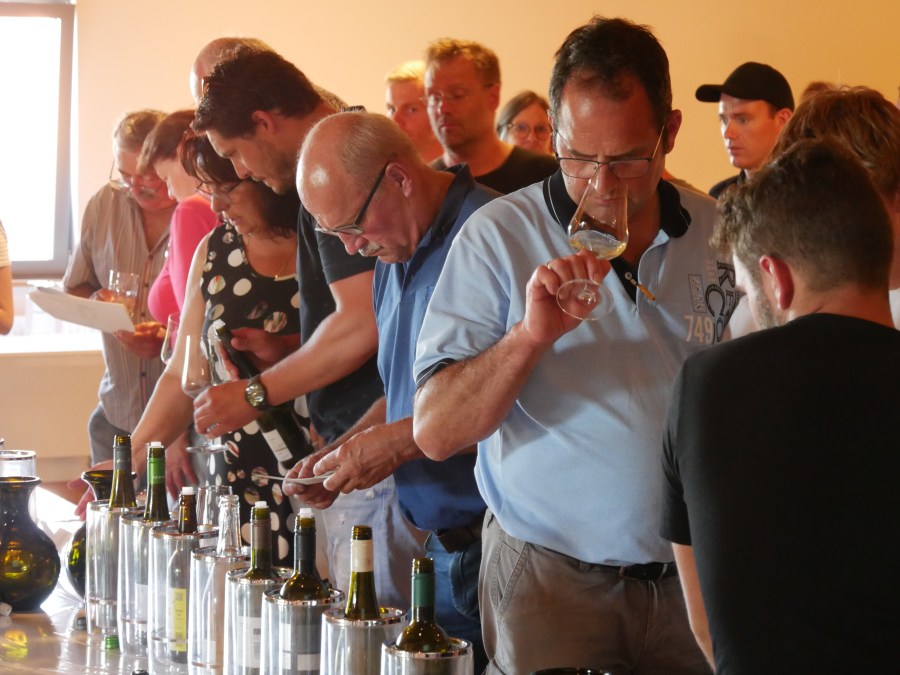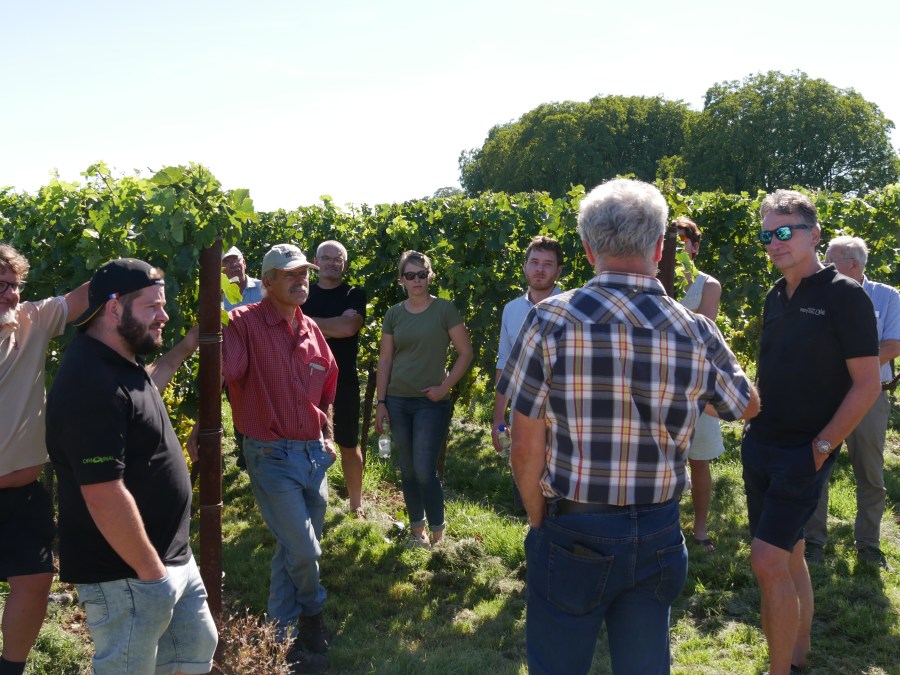The matter of new vine varieties is taken seriously by the German wine industry, so this was well attended.
We were fortunate in being able to call upon Klaus and Karl Rummel, of Bio-Wein Rummel, for their support. Klaus established a direction in vineyard management and wine making many years ahead of others, those that now talk about similar ecological issues; minimising chemical use in the vineyard whilst building up the soils vitality and even vibrancy.
Naturally we wished to show the new vine varieties in their full crop. Thus there were ‘Walks and Talks’ through Souvignier Gris, Cabertin, Sauvignac, Calardis Blanc, Cabernet Blanc, Laurot, Cal 1-28, and Pinotin.
At any given block we had varying aspects of their management outlined to us. Not all being the same, and where indeed many were subject to varying field trials.
Klaus gave a lot of time explaining his philosophy around soil management, whilst illustrating his inter-row systems, the under-vine work, and the alternating row programme of change from one year to the next.
He pointed out a niggly problem that he had and emphasised the work that he now feels he is forced to undertake. This stems from the rather unusual periodic event in German village vineyard management, called Flurbereinigung.
To be honest I do not fully understand the background to this, but it is something along these lines…
Through inheritance blocks of vines get smaller and smaller in their number of rows, as they are divided by the numerous family offspring. Eventually a situation arises where the many rows of vines that you may have, say 25, are indeed made up from many different, and small blocks. It is possible that those 25 rows, in total, are in seven different places. Thus some could be but two rows together, or four…
Come a time when for the ‘collective good’ it is decided that the time has come to return peoples holdings, all into one block, then a whole shoulder of hillside of vines is ripped out, the land lays fallow for a year, then it is all replanted. The workings of the collective thinking, or a power in a committee here, is beyond me.)
Naturally there are benefits to doing this. For example it becomes easier to manage one single large block, than it is to seek out your two rows ‘here’, with another four rows ‘there’, etc.
Also for the collective good the old, weak and often poorly managed blocks are done away with, which can uplift the community standing in the quality stakes of a village.
Gone are the out of date varieties, and in comes the future!
However, supposing that after these changes you end up with a block of soil that previously had been neglected, then you have a lot of work ahead of you to bring it back to life. Regenerative viticulture is not a new subject for these people.
Once, years previous whilst I was working in New Zealand, a visiting German vineyard owner had a look at the soil analysis from a vineyard there, in Nelson, South Island.
He looked at the level of humus and stated: “The decimal point is in the wrong place.”
No, in fact New Zealand ‘new soils’, where not so long ago the land was forested, typically have a humus level ten times greater than those of old vineyards in Germany.
When you have tired old soils such as this, it can be very tempting to rectify matters by throwing sacks of industrial, granular fertilizers at ‘the problem’ but as we know, that is not going to work for you in the long run.
The soil needs, in its heart, a large amount of vitality. It should not be considered as some inert block on which, or in which, vines simply stand. So what Klaus is now faced with is, through his efforts, revitalising that old ‘block’. For those of you so interested in such matters, you no doubt hold your own ideas as to how to go about this. There are mechanical means with which to initially loosen that ‘block’ and there are whole programmes of introducing differing selections of beneficial plants to assist in this as well. For experienced people, we can then see what is happening, and over time.
For example the first thing that we can see after working the soil, are living annual plants coming up, introduced or otherwise. Then come the bi-annual flowering plants.
Next being more perennial types, and these could include nitrogen fixing leguminous plants like clovers, beans, trefoils etc.
By about year four, but definitely five, various grasses are becoming dominant, where grass is nicely ‘functional’ in its durability to work on, but is poor for soil management.
Time to turn the soil over, where to do so is to fold the green swathe just into the surface where you could liken this then to being a form of a green manure.
The timing within the growing year is important to consider as well, where application just prior to flowering can ensure that the vines receive a boost of soil solution, as the competition for it has just been greatly reduced, and this assists a better fruit set.
Thus the above is used to periodically alternate the rows soil management.
Differing regions like to undertake their soil activities at differing times, but if it is done so in a manner where a row becomes available for re-seeding, it helps to do this whilst the soil is warm enough to induce a good germination.
Klaus has a mix of ‘new plants’ in his rows that are a few too many for me to identify and count, but diversity is a key issue here. Beans, oats, sunflowers, turnips, vetch’s, differing brassica types, but not mustard, (where too many of them and its ‘hot’ noxious character is restrictive to soil invertebrate life I’m told,) Rye, Phacelia, and indeed others more than I can see.
Then there are the natural occurring vineyard plants. Live and let live.
“Another friend here who works hard to build up his soils, tells me how pleased he is to find the ‘tell tale’ ploughings in his vineyards, as left by visiting wild boar, as they turn the ground over whilst looking for grubs etc.
This is a whole complex subject, and is as fascinating as listening to winemakers discuss which yeast/why? Or oak, and how to apply its influence…or is it all about the handling of the wine and resulting micro oxidative actions? The questions continue.
I feel that it is worth considering that whilst utilising an extensive seeding programme, that those very seeds all hold adequate nutrient with which to establish new life. As such whether they grow or not, or when they die, or are killed off, they ‘give’ to the soil. After all how many kilos of this seed mix per ha will there be?
People do like to undertake a raft of differing trials in their vineyards as well; it being a good way to continue to learn.
Naturally eco-considerate Germans, like Klaus and the family, use what could be described as ‘collector/tunnel’ sprayers. These are very effective in the early weeks of the growing season where much of the spraying cannot ‘hit the target’, so come around for a second try!
Whilst using a range of Piwi vines, and to be open about this matter not all might be as resistant as you could hope for, (but perhaps they produce good grapes, ones that ripen well for you,) the average across the companies spraying could drop to as low as 4 to 500 g/ha of copper per application. Again every region has its differing disease pressure, so this is a good figure for around here, where others might be naturally more fortunate. (Difficult or even nonesensical to generalise on this matter I feel.)
I do not like copper, as it simply is a broad spectrum toxin, eventually.
We saw other trials in our visit as well, stuff like cropping yields, and saw considerations as to when to drop/cut off the excess.
Differing pruning regimes can really influence crop yield/shoot development, so whilst there are some generalisations about whether or not a vine should be long cane pruned, short caned, or even spur pruned, it is as well to undertake your own trials. Do not be afraid.
What you learn will be greater than any loss you might initially experience.
Likewise just how low can you really, and in practical terms, drop your spray schedule, or concentrations?
As a nursery we are very interested in the relationship between how a vine grows, how the vine picks up the soil solution, and indeed, which rootstock to utilise in the grafting work. Whilst we undertake some trials in these sort of areas, it is through working with our industry colleagues that we can really see what happens on a larger scale. Important stuff.
At the moment there are many concerned growers giving thought as to where best to direct future viticulture endeavours. A technician at a local analytical lab told me that he fields almost as many questions around “what to plant next, (are these new varieties any good…”) as he does around his more basic lab work. Ultimately it is the efforts of the commercial world that shape that which becomes common usage.
And so we came to the tasting of wines, as being brought to the market by the many talented wine makers of this region.
Through the previous few weeks I have attended numerous opportunities to try wines from new varieties. For this visits to research stations and Geisenheim University offered many chances to try wine as generally made in some micro-vinification manner. And they frequently tasted like it. In some ways, yuk, where it is rarely possible to make small quantities in ferments, resulting in a taste like a larger tank result.
There being a skill to seeing beyond the limitations as found in tiny quantity wine making.
However the 42 differing commercial volume wines that were offered back at base after the vineyard visit, at the Freytag office, were generally immensely impressive. All Piwi, all from people who simply work hard in their endeavours to create a sound business with a future, and a cleaner way of life.
Admirable results I thought, where the soil management is good, and in volumes that give efficiencies that ensure a very competitively low price. I feel sure that restricting the cost from spray applications, as well as giving a restricted chemical ‘footprint’, contribute considerably to the companies well being. A helpful marketing line for those so inclined.





